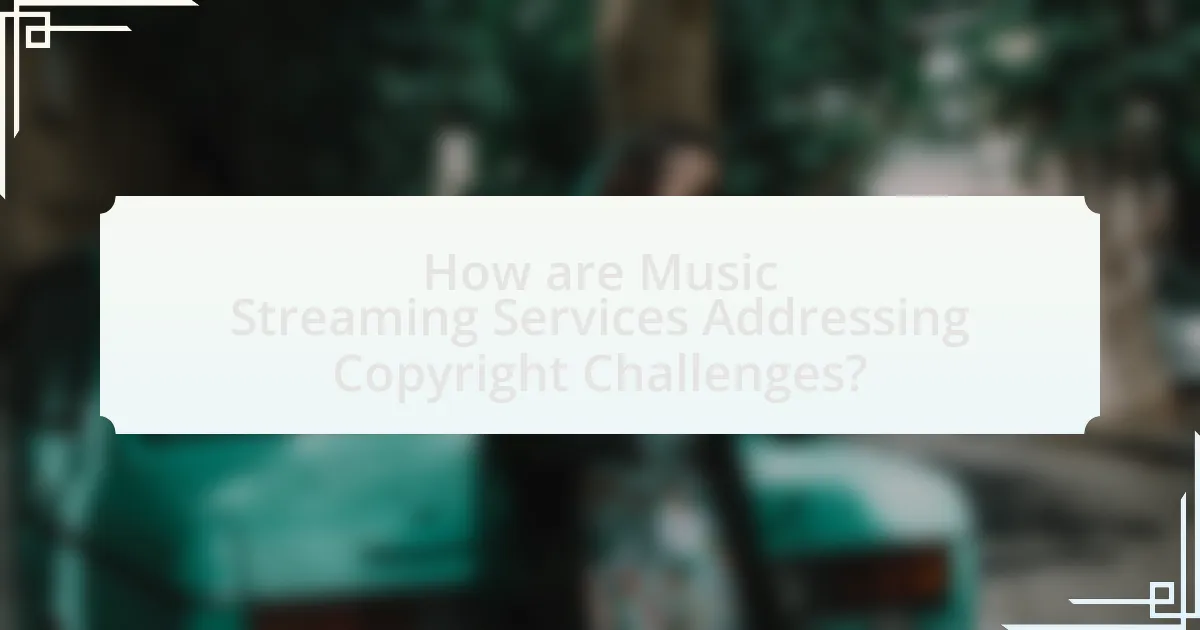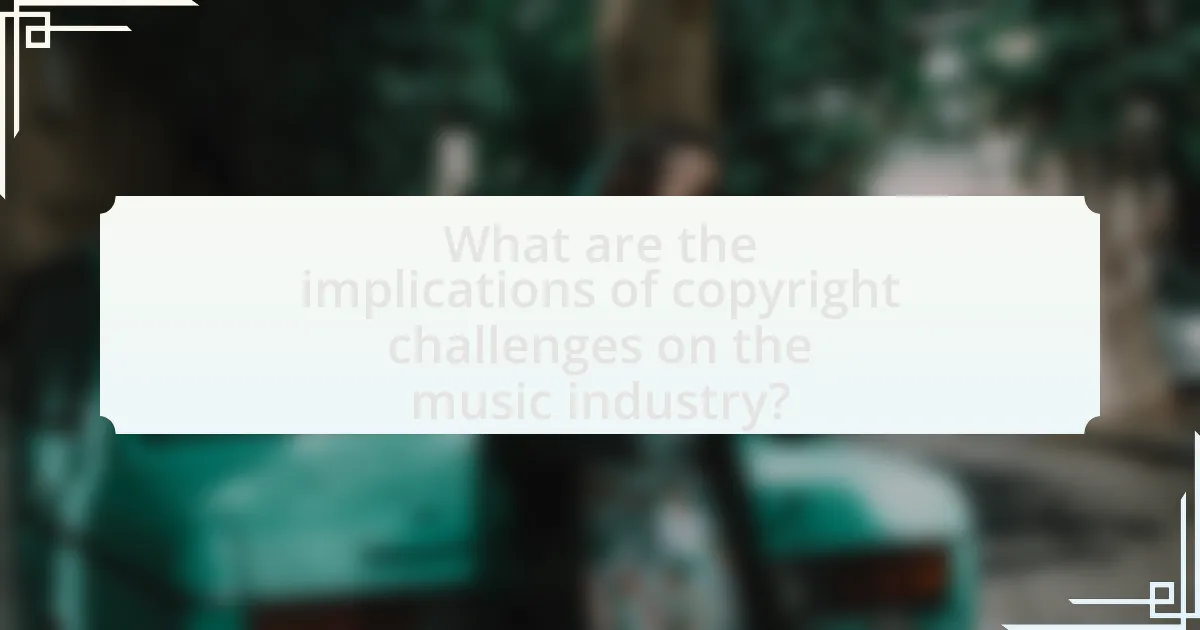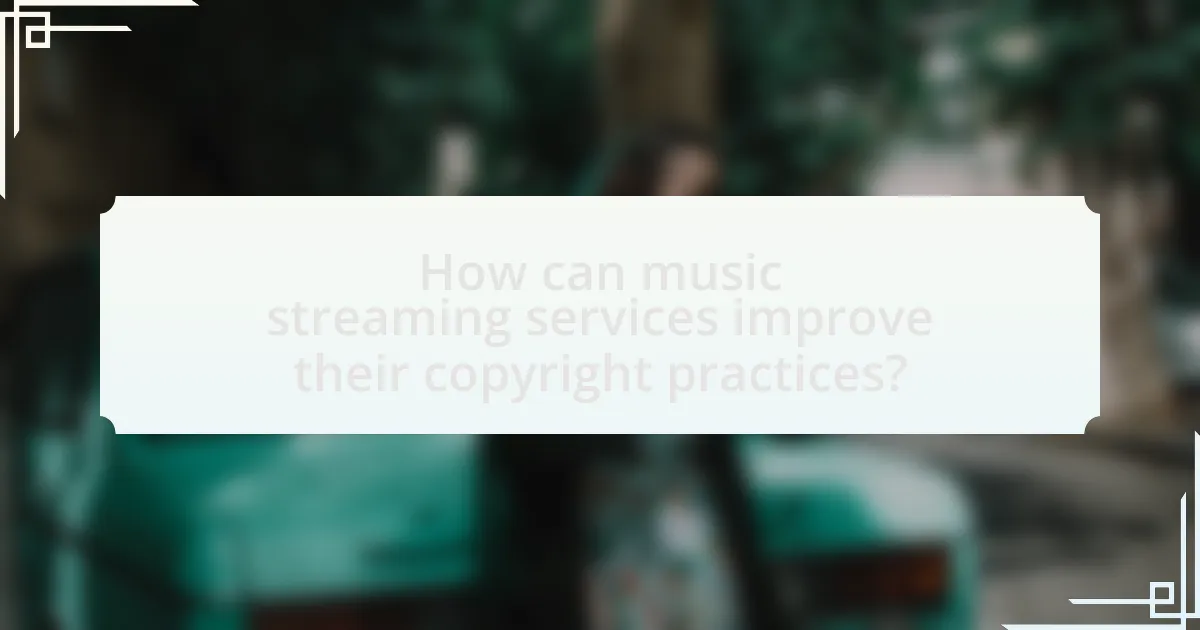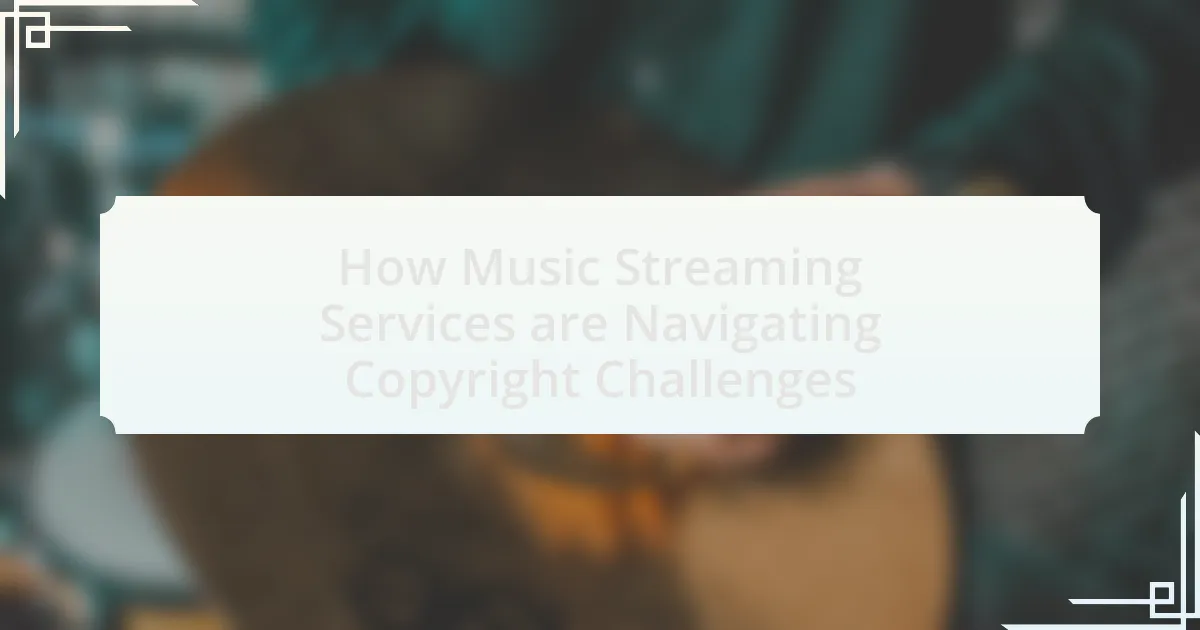Music streaming services are actively navigating copyright challenges through advanced licensing agreements and technology for copyright management. These platforms, including Spotify and Apple Music, negotiate with rights holders to secure legal streaming rights and ensure fair compensation for artists. Key issues faced by these services include licensing complexities, royalty distribution disputes, and the risk of copyright infringement. The article explores the impact of copyright laws on streaming operations, the importance of compliance for user experience, and the strategies employed to address these challenges, including partnerships with rights organizations and the use of innovative technologies. Additionally, it discusses the implications of copyright issues on artist compensation, music diversity, and consumer access to music.

How are Music Streaming Services Addressing Copyright Challenges?
Music streaming services are addressing copyright challenges by implementing advanced licensing agreements and utilizing technology for copyright management. These services negotiate with rights holders to secure licenses that allow them to legally stream music, ensuring that artists and copyright owners receive compensation. For instance, platforms like Spotify and Apple Music have established partnerships with major record labels and independent artists, which facilitate the distribution of royalties based on streaming metrics. Additionally, they employ digital fingerprinting and content identification technologies to monitor and manage copyrighted material, helping to prevent unauthorized use and ensuring compliance with copyright laws. This approach not only protects the rights of creators but also enhances the legal framework within which these services operate, contributing to a more sustainable music ecosystem.
What are the primary copyright issues faced by music streaming services?
Music streaming services primarily face issues related to licensing, royalty distribution, and copyright infringement. Licensing challenges arise from the need to secure rights from multiple stakeholders, including songwriters, record labels, and publishers, which can complicate the legal landscape. Royalty distribution issues stem from the complexity of calculating fair payments to rights holders, often leading to disputes over the amounts owed. Additionally, copyright infringement can occur when services inadvertently stream unlicensed content, risking legal action and financial penalties. These issues are underscored by the evolving nature of digital music consumption and the ongoing debates surrounding fair compensation in the industry.
How do licensing agreements impact music streaming platforms?
Licensing agreements significantly impact music streaming platforms by determining the legal framework through which they can offer music to users. These agreements dictate the terms under which streaming services can access and distribute music, influencing their catalog size, pricing models, and revenue-sharing structures. For instance, platforms like Spotify and Apple Music negotiate licensing deals with record labels and music publishers to secure the rights to stream songs, which directly affects their operational costs and profitability. According to a report by the International Federation of the Phonographic Industry (IFPI), in 2022, recorded music revenues from streaming reached $16.9 billion, highlighting the financial importance of effective licensing agreements in sustaining and growing these platforms.
What role do copyright laws play in the operation of these services?
Copyright laws are essential in regulating the operation of music streaming services by establishing the legal framework for the use of copyrighted material. These laws ensure that artists, songwriters, and producers receive compensation for their work, which is crucial for the sustainability of the music industry. For instance, the Digital Millennium Copyright Act (DMCA) in the United States provides a safe harbor for streaming services, allowing them to avoid liability for user-uploaded content as long as they comply with takedown requests for infringing material. This legal protection encourages platforms to operate while respecting intellectual property rights, thereby fostering a balance between access to music and the rights of creators.
Why is copyright compliance crucial for music streaming services?
Copyright compliance is crucial for music streaming services because it ensures legal protection against infringement claims and fosters trust with artists and rights holders. By adhering to copyright laws, these services avoid costly lawsuits and potential shutdowns, as evidenced by the significant legal battles faced by platforms like Napster and Grooveshark, which were shut down due to copyright violations. Furthermore, compliance allows streaming services to build partnerships with record labels and artists, ensuring a steady supply of content and promoting fair compensation for creators, which is essential for the sustainability of the music industry.
What are the potential consequences of copyright infringement?
The potential consequences of copyright infringement include legal penalties, financial damages, and reputational harm. Legal penalties can involve lawsuits, which may result in injunctions that prevent further use of the copyrighted material. Financial damages can be substantial, with courts awarding statutory damages that can range from hundreds to thousands of dollars per infringement, depending on the severity and willfulness of the violation. Reputational harm can affect individuals and companies, leading to loss of trust among consumers and partners. For instance, the Recording Industry Association of America reported that copyright infringement costs the music industry billions annually, highlighting the significant financial impact of such violations.
How does copyright compliance affect user experience?
Copyright compliance significantly enhances user experience by ensuring access to a diverse range of legal content. When music streaming services adhere to copyright laws, they can offer users a vast library of songs without the risk of legal repercussions, which fosters trust and satisfaction. For instance, services like Spotify and Apple Music invest in licensing agreements that allow them to provide millions of tracks legally, thereby improving user engagement and retention. Additionally, compliance minimizes the likelihood of service interruptions or content removal due to copyright disputes, which can frustrate users. Thus, copyright compliance directly correlates with a seamless and enjoyable user experience in music streaming.
What strategies are music streaming services employing to navigate copyright challenges?
Music streaming services are employing licensing agreements, technology for copyright detection, and partnerships with rights organizations to navigate copyright challenges. Licensing agreements allow these platforms to legally distribute music by compensating artists and rights holders, which is essential for compliance with copyright laws. For instance, services like Spotify and Apple Music negotiate deals with record labels and music publishers to secure the rights to stream their catalogs. Additionally, technology such as Content ID systems helps identify and manage copyrighted material, ensuring that rights holders are compensated when their music is used. Furthermore, partnerships with organizations like the American Society of Composers, Authors and Publishers (ASCAP) facilitate streamlined licensing processes, enabling services to operate within legal frameworks while providing a vast library of music to users.
How are technology and innovation influencing copyright management?
Technology and innovation are significantly influencing copyright management by enabling more efficient tracking and enforcement of rights. Digital tools such as blockchain technology provide transparent and immutable records of ownership, facilitating easier licensing and royalty distribution. For instance, platforms like Audius utilize decentralized networks to ensure artists receive fair compensation directly, bypassing traditional intermediaries. Additionally, machine learning algorithms are employed to identify and manage copyrighted content across various platforms, improving compliance and reducing infringement. These advancements demonstrate a shift towards more automated and precise copyright management practices, enhancing the protection of creators’ rights in the digital age.
What partnerships are essential for effective copyright navigation?
Essential partnerships for effective copyright navigation in music streaming services include collaborations with music rights organizations, record labels, and legal experts. Music rights organizations, such as ASCAP and BMI, provide essential licensing and royalty distribution services, ensuring that creators are compensated for their work. Record labels play a crucial role in negotiating rights and access to music catalogs, which is vital for streaming platforms to offer a diverse range of content. Additionally, partnerships with legal experts help navigate the complex landscape of copyright law, ensuring compliance and minimizing the risk of infringement. These collaborations collectively enhance the ability of streaming services to operate within legal frameworks while supporting artists’ rights.

What are the implications of copyright challenges on the music industry?
Copyright challenges significantly impact the music industry by creating legal uncertainties that affect revenue streams and artist compensation. These challenges often lead to disputes over licensing agreements, which can result in delayed payments to artists and songwriters. For instance, the Music Modernization Act of 2018 aimed to address some of these issues by streamlining the licensing process for digital music services, yet complexities remain, particularly with user-generated content platforms. Additionally, the rise of streaming services has intensified the scrutiny of copyright laws, as these platforms must navigate a landscape where unauthorized use of music can lead to costly lawsuits. The ongoing evolution of copyright legislation continues to shape how artists, labels, and streaming services interact, ultimately influencing the financial viability of music production and distribution.
How do copyright challenges affect artists and creators?
Copyright challenges significantly impact artists and creators by limiting their ability to control and monetize their work. These challenges often arise from complex licensing agreements and the difficulty of enforcing copyright in the digital age, leading to reduced revenue streams for creators. For instance, a study by the International Federation of the Phonographic Industry (IFPI) reported that only 12% of artists earn a living solely from music, highlighting the financial strain caused by inadequate copyright protections. Additionally, copyright infringement can result in legal battles that divert time and resources away from creative endeavors, further hindering artists’ productivity and innovation.
What compensation models are in place for artists on streaming platforms?
Streaming platforms primarily utilize two compensation models for artists: per-stream payouts and subscription revenue sharing. Per-stream payouts involve compensating artists based on the number of times their music is streamed, with rates varying by platform; for instance, Spotify’s average payout is estimated to be between $0.003 and $0.005 per stream. Subscription revenue sharing, on the other hand, allocates a portion of the total subscription fees collected from users to artists based on their share of total streams, meaning that artists benefit more as their music gains popularity. These models reflect the ongoing challenges in copyright management and revenue distribution within the music industry.
How do copyright issues influence the distribution of music?
Copyright issues significantly influence the distribution of music by determining the legal framework within which music can be shared and monetized. Music streaming services must navigate complex copyright laws to ensure they have the necessary licenses to distribute songs legally. For instance, the Digital Millennium Copyright Act (DMCA) in the United States requires platforms to remove infringing content upon notification, which can lead to the removal of popular tracks and affect user experience. Additionally, licensing agreements with rights holders dictate the availability of music on these platforms, impacting the catalog that users can access. According to a report by the International Federation of the Phonographic Industry (IFPI), 75% of music streaming revenues are allocated to rights holders, highlighting the financial implications of copyright compliance on service profitability and content availability.
What impact do copyright challenges have on consumer access to music?
Copyright challenges significantly restrict consumer access to music by limiting the availability of songs on streaming platforms. When copyright disputes arise, music rights holders may withdraw their content from services, leading to gaps in libraries and reduced choices for consumers. For instance, in 2020, disputes between major labels and streaming services resulted in the removal of thousands of tracks, illustrating how legal issues directly affect what users can listen to. Additionally, the complexity of licensing agreements can delay the release of new music, further hindering access. Thus, copyright challenges create barriers that diminish the overall consumer experience in music streaming.
How do licensing fees affect subscription costs for users?
Licensing fees significantly increase subscription costs for users of music streaming services. These fees are payments made to copyright holders, such as artists and record labels, for the right to stream their music. For instance, according to a report by the International Federation of the Phonographic Industry, music streaming services allocate a substantial portion of their revenue—often around 70%—to cover these licensing fees. Consequently, as these fees rise due to negotiations or changes in copyright laws, streaming services may pass on the increased costs to users through higher subscription prices. This direct correlation between licensing fees and subscription costs illustrates how copyright challenges impact the financial landscape of music streaming.
What are the implications for music diversity and availability?
The implications for music diversity and availability are significant, as music streaming services influence the accessibility and variety of music genres. These platforms often prioritize popular or mainstream content due to licensing agreements and algorithms that favor widely consumed music, which can limit exposure to niche or diverse genres. For instance, a study by the University of Southern California found that 90% of streams on major platforms come from just 10% of artists, indicating a concentration of popularity that can overshadow lesser-known musicians. Consequently, while streaming services provide access to a vast library of music, they may inadvertently restrict the diversity of music available to listeners by promoting a narrow selection of popular tracks over a broader range of artistic expressions.

How can music streaming services improve their copyright practices?
Music streaming services can improve their copyright practices by implementing more transparent licensing agreements and utilizing advanced technology for tracking usage. Transparent licensing agreements ensure that artists and rights holders are fairly compensated, as evidenced by the 2021 Music Modernization Act in the United States, which aimed to streamline the process of obtaining licenses and ensuring payments. Additionally, employing technology such as blockchain can enhance tracking of music usage, providing a more accurate accounting of plays and royalties, which has been shown to reduce disputes over payments and improve trust among stakeholders in the music industry.
What best practices should music streaming services adopt for copyright management?
Music streaming services should adopt a comprehensive copyright management strategy that includes robust licensing agreements, transparent reporting systems, and proactive monitoring of content usage. Licensing agreements ensure that rights holders are compensated fairly, as evidenced by the Music Modernization Act of 2018, which streamlined the licensing process for digital music services. Transparent reporting systems allow for accurate tracking of plays and royalties, fostering trust between platforms and artists. Proactive monitoring of content usage helps identify unauthorized distributions, which is crucial given that the global music industry lost approximately $2.7 billion to piracy in 2020. By implementing these best practices, music streaming services can effectively navigate copyright challenges while supporting artists and rights holders.
How can transparency in licensing agreements benefit all stakeholders?
Transparency in licensing agreements benefits all stakeholders by fostering trust, ensuring fair compensation, and facilitating clearer communication. When music streaming services openly share the terms of their licensing agreements, artists and rights holders can better understand how their work is being used and compensated, leading to more equitable revenue distribution. For instance, a study by the International Federation of the Phonographic Industry (IFPI) in 2021 highlighted that transparent practices in licensing can increase artist satisfaction and engagement, ultimately driving more content creation. Additionally, transparency helps streaming platforms mitigate legal risks and enhance their reputation, which can attract more users and investors.
What role does user education play in copyright awareness?
User education plays a crucial role in enhancing copyright awareness by informing individuals about their rights and responsibilities regarding copyrighted materials. Educated users are more likely to understand the implications of copyright infringement, which can lead to more responsible consumption and sharing of content. For instance, studies indicate that users who receive training on copyright laws are 50% more likely to respect copyright regulations compared to those who do not receive such education. This increased awareness helps mitigate legal risks for both users and music streaming services, fostering a culture of respect for intellectual property.
What future trends might shape copyright navigation in music streaming?
Future trends that might shape copyright navigation in music streaming include the rise of blockchain technology, increased use of artificial intelligence for copyright management, and evolving legal frameworks that adapt to digital distribution. Blockchain technology can provide transparent and immutable records of music ownership and usage, facilitating fair compensation for artists. Artificial intelligence can streamline the identification of copyrighted material, improving the efficiency of licensing processes. Additionally, as governments and regulatory bodies respond to the complexities of digital content, new laws may emerge that redefine copyright protections and obligations for streaming services, ensuring that they align with the realities of the digital age.
How might changes in technology alter copyright enforcement?
Changes in technology can significantly alter copyright enforcement by enabling more efficient tracking and monitoring of copyrighted content. Advanced algorithms and machine learning tools allow for real-time identification of unauthorized use of music across various platforms, making it easier for copyright holders to enforce their rights. For instance, platforms like YouTube utilize Content ID technology to automatically detect copyrighted material, which has led to a more proactive approach in managing copyright issues. Additionally, blockchain technology offers a decentralized method for tracking ownership and usage rights, potentially reducing disputes and enhancing transparency in copyright enforcement. These technological advancements create a more robust framework for protecting intellectual property in the digital age.
What emerging models could redefine copyright in the music industry?
Emerging models that could redefine copyright in the music industry include blockchain technology, decentralized platforms, and user-centric payment systems. Blockchain technology offers transparent and immutable record-keeping, enabling artists to receive direct payments for their work without intermediaries, as evidenced by platforms like Audius and Ujo Music. Decentralized platforms allow for peer-to-peer sharing and distribution of music, which can challenge traditional copyright frameworks by facilitating direct artist-to-fan interactions. User-centric payment systems, such as those proposed by the streaming service Napster, aim to allocate royalties based on actual listening habits, ensuring that artists are compensated fairly according to their audience engagement. These models collectively address existing copyright challenges by promoting fairness, transparency, and direct artist compensation.
What practical steps can music streaming services take to enhance copyright compliance?
Music streaming services can enhance copyright compliance by implementing robust licensing agreements with rights holders. These agreements ensure that all music content is legally obtained and that artists receive appropriate compensation. Additionally, services can utilize advanced content identification technologies, such as digital fingerprinting, to monitor and manage copyrighted material effectively. For instance, platforms like YouTube employ Content ID systems to automatically detect and manage copyrighted content, which helps in maintaining compliance. Furthermore, regular audits and transparency reports can be conducted to assess compliance levels and address any discrepancies, thereby reinforcing trust with rights holders and users alike.

Leave a Reply